2011 | Retrospective
Ingmar Bergman – Film as Life and Life as Film
In February 2011 you can look forward to rediscovering with open eyes and a dose of eager anticipation the multifariously rich work of the Swedish director Ingmar Bergman. The Retrospective reveals a highly productive and creative director, in whom biographical and artistic spheres blend seamlessly together, and who “liberated cinema, freed it from conventions and brought it to a new artistic form, which opened a new world for many cineastes.” A talk with the director of the Retrospective, Rainer Rother, about Bergman’s crucial work at the very core of film, the relationship between acting and aesthetic conception and his continued function as a role model for filmmakers around the world.
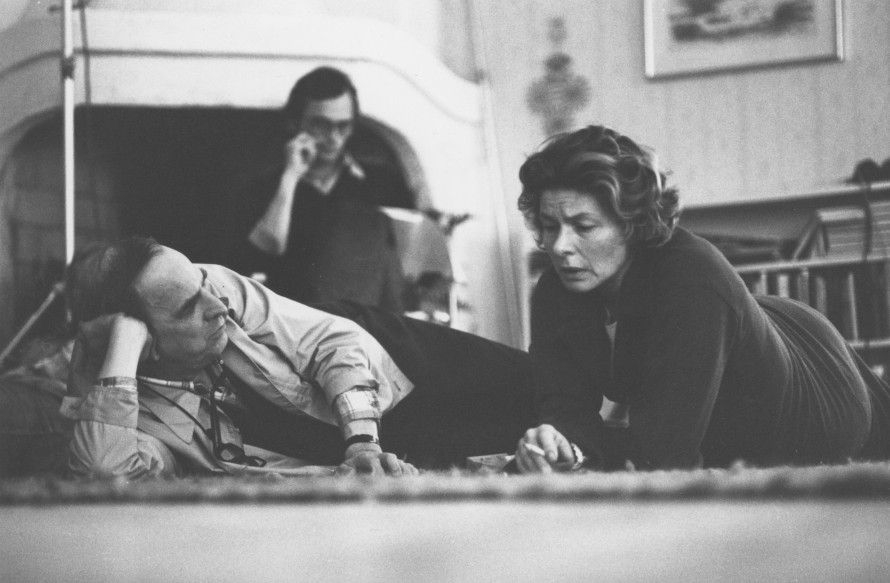
Ingmar Bergman and Ingrid Bergman during the shooting of Herbstsonate (Autumn Sonata)
What was the main motivation behind your decision to dedicate the Retrospective 2011 to Ingmar Bergman? What are the special significance and topicality of his work for contemporary audiences?
RR: For us, this Retrospective is closely connected to the exhibition “Ingmar Bergman – Truth and Lies”, showing in the Filmhaus am Potsdamer Platz. For the exhibition we received materials from Bergman’s personal estate from the Bergman Foundation and the Swedish Film Institute, items which have never been exhibited before. This is a sensation, and – alongside exhibits from our own archives and international collections – it made sense to show Bergman’s films. Bergman is not an unknown director, he’s not a discovery, if you like, but one of the most famous directors of the European auteur film that one could imagine. At the same time one has to assume that his work is virtually no longer present in the cinema, the place for which it was made, which is unfortunately – due to the general decline of repertory cinema – the case for many famous artists from the history of film.
Nonetheless, can one still make new discoveries when it comes to such a luminary of European cinema?
Definitely. For example, Bergman’s early film work is virtually unknown. This is an interesting phase of self-discovery, in which he has yet to become the Ingmar Bergman, the international fame he became in the mid-1950s. Back then, he sometimes still worked with scripts by others and wrote screenplays that were filmed by other directors. But in his later films, too, one doesn’t always find what one expects.
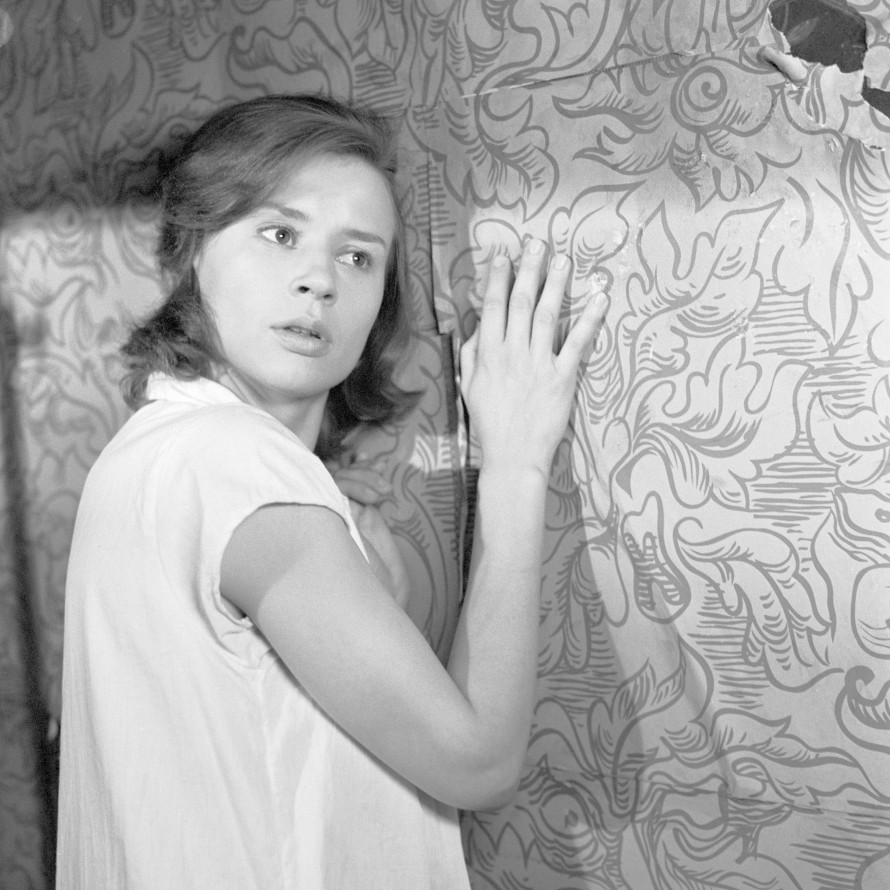
Harriet Andersson in Såsom i en spegel; © 1961 AB Svensk Filmindustri
Untarnished view
Wim Wenders once put it nicely when he said that watching Bergman films is obscured by the “blind window of ‘opinions’”, but that they deserved “to be watched without any bias whatsoever”. I find that to be a wonderful image for dealing with a director who is far too quickly pigeonholed as intellectual, profound and serious. If you look closer, you see everything including the surface, the beauty of the image, the casualness and lightness with which Bergman captures daily occurrences. It is a truly rich body of work.
How much can Bergman be considered a role model for other filmmakers?
I believe that Bergman, along with the likes of Orson Welles, is one of the few directors who had a formative influence on many filmmakers and still does. In our catalogue for the exhibition there is a series of interviews with directors who describe the important role of Bergman for their work. Through these discussions one gets a good sense of the importance Bergman had on international cinema: that of an artist who expanded the very language of film. For Michael Haneke, Bergman is a great role model for the depiction of interpersonal relationships. Hans-Christian Schmid studied Bergman’s Såsom i en spegel (Through a Glass Darkly) in preparation for his film Requiem. Margarethe von Trotta, who Bergman knew well personally, felt very close to him in the portrayal of conflicts of conscience and in the depiction of strong female personalities. Bergman is one of the few who liberated cinema, freed it from conventions and brought it to a new artistic form, which opened a new world for many cineastes.
Many of Bergman’s films weren’t easy for cinemagoers at the time – for example his emphatic use of drastic, formal processes such as his self-referential stylistic methods. How accessible are his films today?
I believe Bergman is very clear. He very much keeps his focus on the fundamental conflict that is inherent in his various subject matters, by not adding other unnecessary material. His starting point is always the people, the characters and their stories and he tries to show them as simply and as directly as possible.
That can lead to extremely stark films such as Aus dem Leben der Marionetten (From the Life of the Marionettes), which is very reduced in its formal language. But it can also result in opulent cinema as in Fanny och Alexander (Fanny and Alexander), which appeared just two years later and is different in every respect. It’s not black and white, but colour. It’s not reduced to a few people, but is nothing less than a magnificent portrait of an entire social class. From the very beginning the relationships in this large bourgeois household are humorously and lovingly portrayed.
The appropriateness of his approach to the material is one of Bergman’s trademarks: he doesn’t allow himself to be distracted from what he actually wants to show. And he doesn’t allow himself to be seduced into doing more than is necessary.
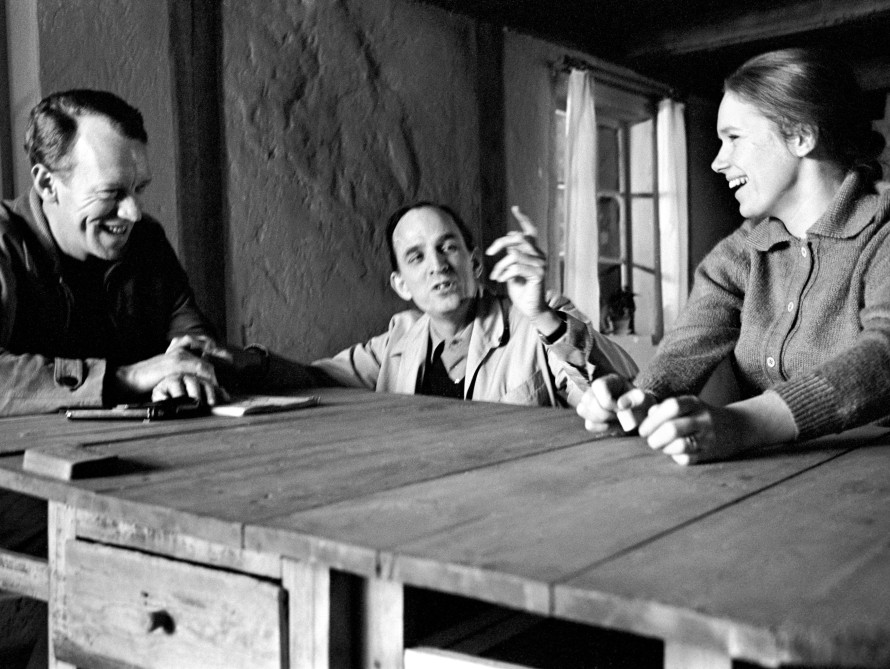
Max von Sydow, Ingmar Bergman and Liv Ullmann on the set of Vargtimmen (Hour of the Wolf)
Trust as the basis of productive work
This also becomes clear in the documentary on his work by Stig Björkman, which we will be presenting during the Retrospective as accompanying material. It shows an extraordinarily precise, but very organized worker. One also realizes immediately how important the team was for Bergman. Over many years he worked very intensively with various people, and not just with actors. He shot most of his films with only two camera operators. He relied on the same still photographers, and often worked with the same costume and production designers. One senses an atmosphere of trust and dependability which made relaxed and very rapid work possible. This was absolutely necessary, if one considers how much Bergman achieved: alongside about 40 films for the cinema and around 20 television productions, he produced an unbelievable amount of theatre work. He also wrote autobiographical books and a large number of scripts. All this is only possible if one feels at ease in an environment which makes possible this truly immense body of work.
Could one even say these many years of working together created a sense of family?
Just as one speaks of the “John Ford Family”, there was certainly a “Bergman Family” that formed around him. With Bergman you can add the fact that his work is connected to many personal stories: such as his love affairs with various actresses and the resulting children. It is interesting to see how Bergman’s work and biography overlap in a very unique way. Not only are his films based upon biographical experiences. His autobiography itself is written as if it were a film. In no way does the autobiography describe the real life of Ingmar Bergman. It contains much inspiration that derives from the films. That is why we have named the exhibition “Truth and Lies”. In a way this title is also relevant for the Retrospective.
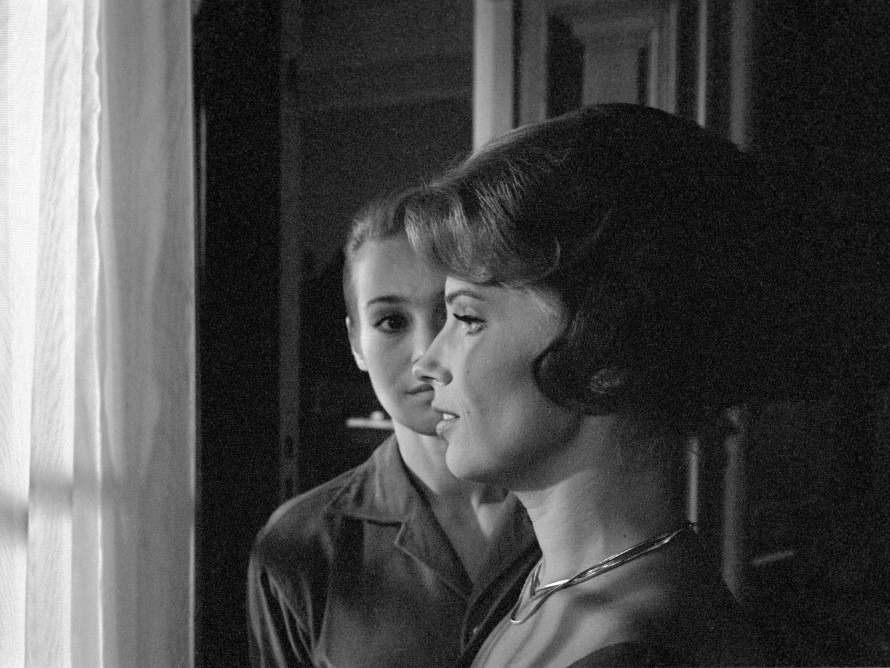
Ingrid Thulin and Gunnel Lindblom in Tystnaden (The Silence)
That is interesting, because one usually thinks about these spheres independently from one another. On the one hand you have the personal experiences and on the other hand the artistic work, into which these autobiographical themes have flowed. How do Bergman’s personal life experiences such as his many years of theatre work become apparent in his films?
His work in theatre plays a role simply because he worked with the same actors as in his films: Bibi Andersson, Harriet Andersson, Gunnar Björnstrand, Eva Dahlbeck, Gunnel Lindblom, Max von Sydow and Ingrid Thulin. Bergman has a truly extraordinary feeling for his actors, which surely has something to do with his work in the theatre. His directing of actors is virtually incomparable. He is very tolerant and open which allows him to achieve a remarkable intensity.
With regards to the biographical influences: especially in his final projects he vigorously tackled his own history, his childhood, but also the story of his parents. Fanny and Alexander is surely a film soaked in autobiographical material. The interweaving of the biographical and the cinematic runs through his entire oeuvre and can be seen clearly in his screenwriting projects: Hets, Trolösa (Faithless) and Den goda viljan (The Best Intentions) tap into images from memory and show how closely linked Bergman’s life and artistic work are. There, one sees how great a role his own life and experience played.
Already in the 1960s, Bergman claimed he had overcome his grapple with the religiosity of his parental home in his films. Yet this theme is still very present in his autobiography “The Magic Lantern” and in his later films…
Bergman did categorise his own work and say: here’s my Faith Trilogy or here’s my Chamber Play Trilogy. For sure, there is some truth to this division, because the films communicate closely with one another. But there are in fact certain themes that preoccupied him for his entire life. There is no question that his exploration of religiosity, belief, and formalized, organized religion, belong to this, but other issues are no less important. We structured the film programme of the Retrospective along such central themes like “Search”, “Artist”, “Faith”, “Relationships” and “Life and Work”. Structured along seven similar chapters, the exhibition also sheds light on the central motifs and phases of Bergman’s life.
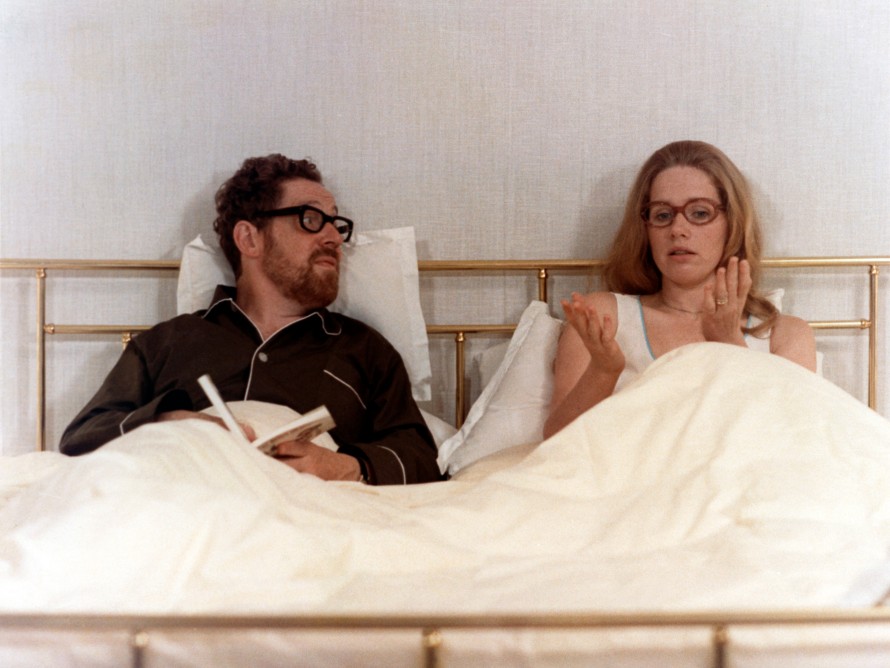
Erland Josephson and Liv Ullmann in Scener ur ett äktenskap
Precision and playful freedom
Could one describe the work of Bergman – his visual compositions, his use of light and actors, his “stylistic and moral rigor” as you have called it – as meticulous? How does this rigor relate to the relatively free, improvised approach to scripts, which Bergman granted his actors later in his career?
His images are, in some cases, composed with such precision that one never forgets them again. But it’s not as if Bergman thinks exclusively in terms of the image. Working with the cameraman he tries to develop pictures in which the characters “appear”. The pictures are not independent from what the actors are doing. Of course there are also tableaus, which are reminiscent of the compositions of the visual arts.
I don’t have the feeling that the stylistic concept overwhelms the storyline. The actors seem to feel at ease in Bergman’s frames. You see this well in Scener ur ett äktenskap (Scenes from a Marriage), which works with a lot with close-ups and which is often very strict in its framing. The actors have some very long scenes and can develop their acting within a single shot in a most fascinating way.
How much of the visual composition would you attribute to cinematographer Sven Nykvist?
The cameraman is ultimately responsible for the picture. You can see this very well in the documentary by Bergman’s friend Stig Björkman. Bergman often looks through the camera and wants to know what the image looks like, but the final composition, the light, the focus, that of course comes from Sven Nykvist, or – in the earlier films – from Gunnar Fischer. With this type of close collaboration, you are often only as good as the team you’re in and you see the result in the films themselves.
If I understand correctly, Stig Björkman’s documentaries are less snapshots and more the result of a long process of accompaniment.
Björkman observed Bergman’s work as a companion over a long period of time. He documented the preparation and the filming of Beröringen (The Touch) and shot long interview sequences with Bergman, which can be seen in Ingmar Bergman (Stig Björkman, 1970-72). In 2009 and 2010 he made Bilder från lekstugan (Images from the Playground) and ...men filmen är min älskarinnad (... but Film is My Mistress). These two compilations are based on the extensive “behind the scenes” footage that Bergman and his team captured over many years with 9.5mm and 16mm cameras during shoots. Due to the extraordinary proximity, these recordings were made amidst a very free environment and are often suggestive of home movies – very different to today’s “making of” productions, which are normally under the control of the production company. Bergman even sometimes used this material to advertise his films – we’ll be showing some examples of this in the Retrospective. With the support of the World Cinema Foundation the material could be restored, making Björkman’s compilation films available to a broad audience for the first time.
There is little doubt of Ingmar Bergman’s positioning in European cinema. Do you see tendencies that point beyond this horizon?
I believe that he is, in fact, a very European filmmaker, especially in the way that certain theatrical, literary and artistic motifs mark his films. But he is a European filmmaker who, not without reason, was nominated for the Oscar several times and won it twice. Nevertheless, he always kept a certain distance between himself and American cinema. He probed the US market through his American agent, but he was never guaranteed artistic freedom – an absolute precondition for his work - in any of the projects that were offered to him.
Creative centre, economical working methods
With regard to American cinema, economics come to mind. On the one hand, Bergman was able to do what he wanted as an auteur relatively early on. On the other hand, he never had an especially large production budget for any of his films. Does the secret of his cinema perhaps lie in sparseness, with regards to both style and finances?
Bergman made his first films for Svensk Filmindustri and more than 30 of his roughly 40 cinema productions were produced or co-produced by them. The artistic consultant for his first two works there, Hets (script and assistant director) and Kris (Crisis) was Victor Sjöström. The great silent movie director influenced and supported Bergman and even acted in two of his later films: in Till glädje (To Joy) and in Smultronstället (Wild Strawberries). The cooperation with Svensk Filmindustri didn’t always run smoothly and especially in the early years, several different production companies backed Bergman’s films. Fundamentally, however, Bergman was always THE creative centre of films for his entire career and that is naturally a privileged position that not many filmmakers experience. This question is perhaps more important than that of production budgets. Anyhow, Bergman’s working style was surely very economical, because he never wanted to add anything to what he did. His camera movements are the camera movements that he wanted to do, and they were never supposed to spice up the subject. He didn’t have to shoot an endless number of takes or shoot the same scene from many different angles. None of that interested him. He was always very close to the core of his story and wanted to show it.
From the late 1970s, Bergman was co-producer of his own films with his company Cinematograph. With Cinematograph he produced his only two documentaries: Fårö-dokument (1969) and Fårö-dokument 1979. Both of these films about the residents of the Fårö Islands are a loving homage and at the same time a critical look to life on an isolated island that was Bergman’s chosen home for many years. Ingmar Bergman as a documentary maker was a real discovery for us.
What did the young film critics and later Nouvelle Vague directors mean with their description of Bergman as “The classic of the Modern”?
When the Nouvelle Vague began, Bergman had already brought home his first awards, at all three big festivals in Cannes, Venice and Berlin, where he received the Golden Bear as his first really big prize for Wild Strawberries. When these young film enthusiasts prepared to tear from its foundations the ‘quality cinema’ of the era – the sedate, conventional and endlessly serious films -, Bergman had already completed this revolution for himself within in a very different context. For this reason, he could also continue in the same way, relatively unchallenged by the upheaval, and didn’t have to change his way of making films. Through his films he won great respect, especially amongst these rebels who loved and admired his work.
Looking back, one can say, without hesitation, that Bergman belongs to the great artists of the 20th Century, that he is, in this sense, a ‘classic of the Modern’.